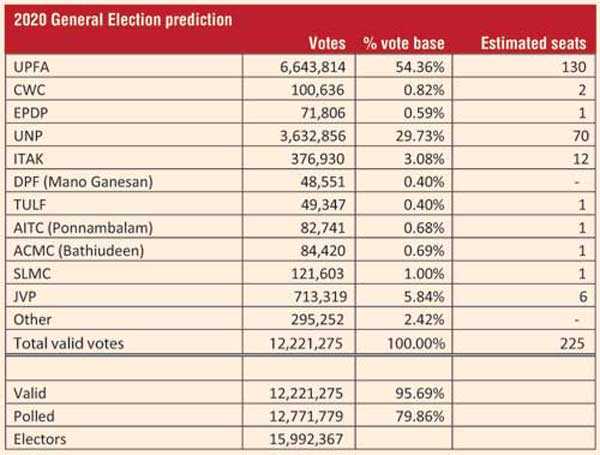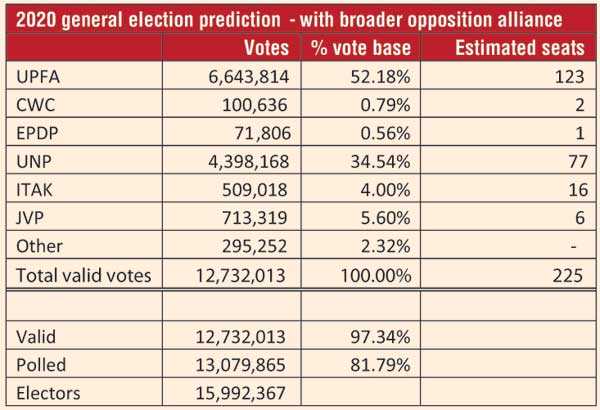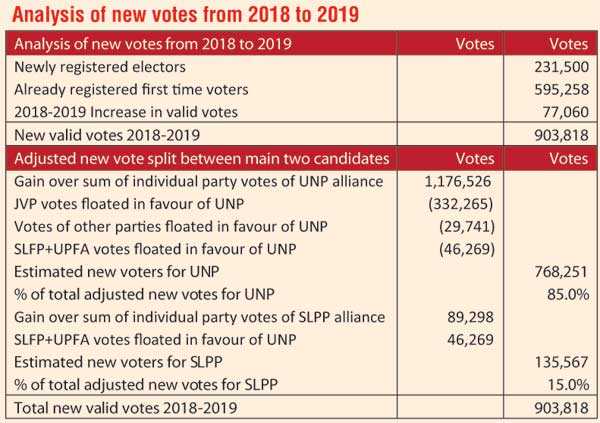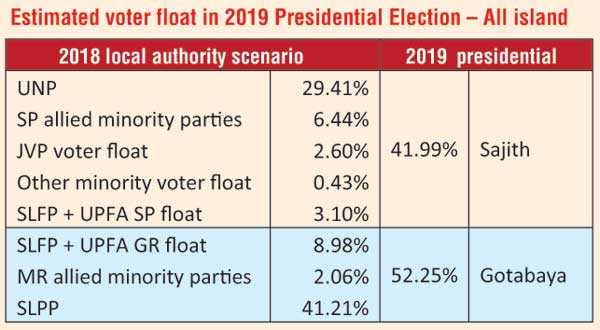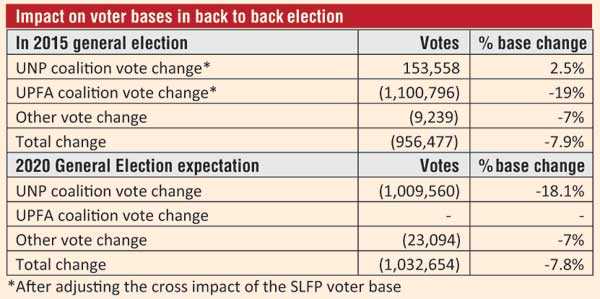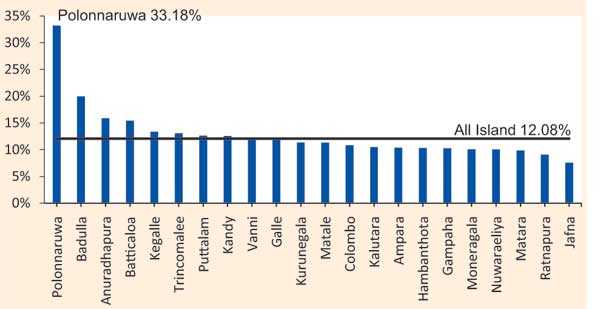Tuesday Dec 30, 2025
Tuesday Dec 30, 2025
Tuesday, 11 February 2020 00:04 - - {{hitsCtrl.values.hits}}
In Sri Lanka, election victories largely depend on the right formation of political alliances. 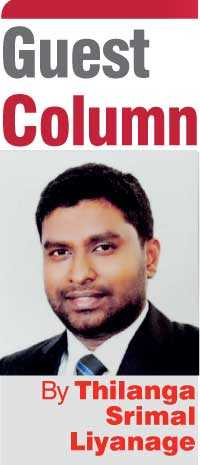
Based on the last Local Authority Election in February 2018, which is the most recent election that parties contested individually, Sri Lanka Podujana Peramuna (SLPP) gained the largest number of votes, accounting for 41.28% of total valid votes. The rest was distributed among United National Party (UNP) 29.41%, SLFP 12.08%, People’s Liberation Front (JVP) 5.75% and aggregated base of main ethnic parties accounted for 8.1%. It is clear that SLFP has now become a significant third force deciding the future election victories in the country.
The SLFP officially supported Gotabaya Rajapaksa in the recently-concluded Presidential Election that made him the president. Most SLFP supporters voted for Gotabaya in 2019 and majority of them are estimated to have voted for the former President Maithripala in 2015. Estimated SLFP voter float is shown in the tables.
A prominent political figure from the left aligned SLFP would have been the best possible common candidate option against Gotabaya at the last presidential election. It might have minimised the SLFP floating base in favour of Gotabaya while the other voters aligned with UNP and minority ethnic parties are unlikely to have voted in favour of Gotabaya.
An official SLFP support to Sajith Premadasa would have resulted in a relatively higher voter float to Gotabaya as they may align more with the Gotabaya camp as they are a breakaway faction of SLFP. However, an official support could have resulted in a major portion voting in favour of Sajith, resulting in no one securing 50% at the first count. Yet, Gotabaya is expected to have lead at the first preference count and Sajith may overtake at the second preference count. Estimated outcomes are shown in the tables.
Party leader Maithripala is the best performing organiser among all other district organisers in SLFP. He represents Polonnaruwa and claims for the largest SLFP vote base of 33.18% in the last local authority election in 2018. After being in office for three years as the President, Maithripala managed to maintain the strongest base for his party in Polonnaruwa, significantly higher than other districts.
Sajith’s more centred ethnic political agenda has attracted more floating votes than Gotabaya in the recent election. A fraction of vote bases of each minority political parties who supported Gotabaya including Sri Lanka Freedom Party (SLFP) and Ceylon Workers’ Congress (CWC) is estimated to have voted in favour of Sajith. In Nuwara Eliya district, nearly half of CWC’s 20.97% vote base and entirety of SLFP’s 10.02% vote base is estimated to have voted in favour of Sajith.
Nuwara Eliya is largely a district consisting of minority population (Tamils 58%, Sinhalese 40% and Muslims 2%). Regardless of ethnicity, nearly 45% of the SLFP vote base in Polonnaruwa District is also estimated to have favoured Sajith. Population in Polonnaruwa is largely Sinhalese Buddhists (91% Sinhalese, 7% Muslims and 2% Tamils). Further, in most districts, a portion of People’s Liberation Front (JVP) is also estimated to have favoured Sajith. Where net gain positions of district floating votes are concerned, Nuwara Eliya recorded highest net gain for Sajith, second being Jaffna and Polonnaruwa third. Gotabaya was only able to record net gains in Hambantota, Matara, Galle and Moneragala Districts.
From February 2018 local authority election to November 2019 Presidential Election there were 231,500 newly registered voters and new valid votes of already registered votes amounted to 595,258. Altogether, the total new valid votes saw an increase of 903,818 votes from 2018 to 2019. As shown in the table, it is estimated that 85% of the new valid votes were in favour of Sajith in 2019.
Sri Lankan voters are predominantly party aligned and the voter decision is influenced by their party directives. Genuine floating voters concerned about national level issues are just an insignificant minority. National security is the most recent and widely debated national concern which emerged soon after the Easter Sunday attack in April 2019. St. Sebastian Church in Katuwapitiya, Negombo was the worst affected location in the chain of bomb blasts. Katuwapitiya is located in the Katana electorate, governed by two urban councils namely Katana Pradeshiya Sabha and Katunayake-Seeduwa Urban Council. Katana electorate largely constitutes Sinhalese Catholics (Sinhalese 91.60%, Muslims 1.44%, and Tamils 4.62%). Sajith managed to increase his vote base in Katana from 2018 despite accusations of national security failures from his Government. Neighbouring Negombo electorate also showed a similar trend, resulting in a higher SLFP floating votes in favour of Sajith.
Negombo is yet again largely populated by Sinhalese (Sinhalese 75.63%, Muslims 13.67%, and Tamils 8.9%, however represent a relatively higher minority population base than Katana. Most of them are Roman Catholics representing 65.3% of the population while Buddhists represent 11.07%.
It is important to mention that, ethnic political party ACMC led by prominent Muslim political leader, Bathiudeen, has only secured a 2.58% in 2018 local authority election. Hence, it is evident that voters in Negombo and Katana have favoured centred ethnic political views than national security. Estimated voter distribution is depicted in the tables.
Back-to-back election results in an uplift to the winning party’s base caused by low voter turnout for the main opposition. De-motivated voters allied with the losing party abstaining from voting in a back-to-back election. However, minority parties are likely to maintain their bases.
At the General Election in 2015, all island valid votes dropped by 7.9% compared to the presidential election in the same year. It is estimated that UPFA lost 1.1 million in absolute votes, a 19% reduction from the presidential election count. The winning party, the UNP, is estimated to have obtained additional 153,558 votes, resulting in a 2.5% increase from the Presidential Election count.
A similar impact can be expected in the next General Election due in April. All island valid voter count is expected to decline by 7.8% (including expected low voter turnout and increasing rejected votes), accounting for an absolute number of around one million. The JVP is expected to regain its base due to the impactful role of a third force in Parliament. The winning party or SLPP+SLFP coalition and minority ethnic parties are expected to maintain their voter bases. Hence, the governing coalition, SLPP+SLFP, is expect to secure a majority 54.36% with 130 seats (133 with EPDP and CWC anticipated support) and main opposition, UNP’s voter base is expected to drop to 29.73% with 70 seats.
The main opposition, UNP, is currently negotiating with minority parties to form a broader alliance for the next parliamentary election. Contesting through a broader alliance will boost the voter sentiment, minimising the level of low voter turnout for UNP. This may enable the alliance to win few more districts and secure additional bonus seats and national list seats.
Coalition with minority Muslim ethnic parties and Mano Ganesan led DPF is the most likely and easily workable alliance for the opposition. Tamil ethnic parties in the north and east are likely to contest from a separate alliance due to strong minority population base in the region. Tamil ethnic parties who supported Gotabaya (EPDP and CWC) are likely to contest individually to minimise minority voter float to opposition. They may have negotiated terms when pledging support to Gotabaya at the presidential election. Hence, we believe this hypothetical alliance scenario will result in 126 seats for the UPFA Government and 77 seats for the UNP-led alliance.
(The writer is a financial analyst with over 15 years of experience in investment research both locally and overseas.)

